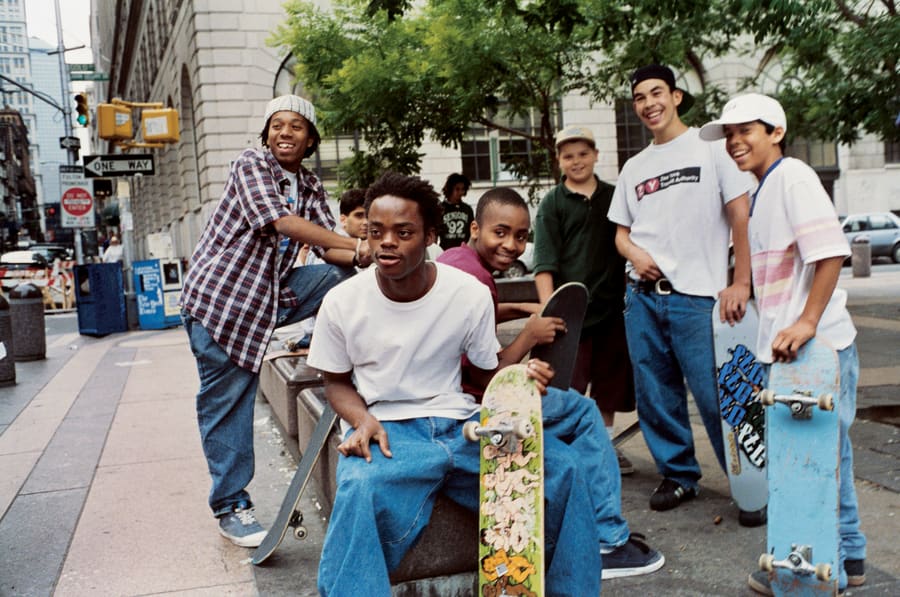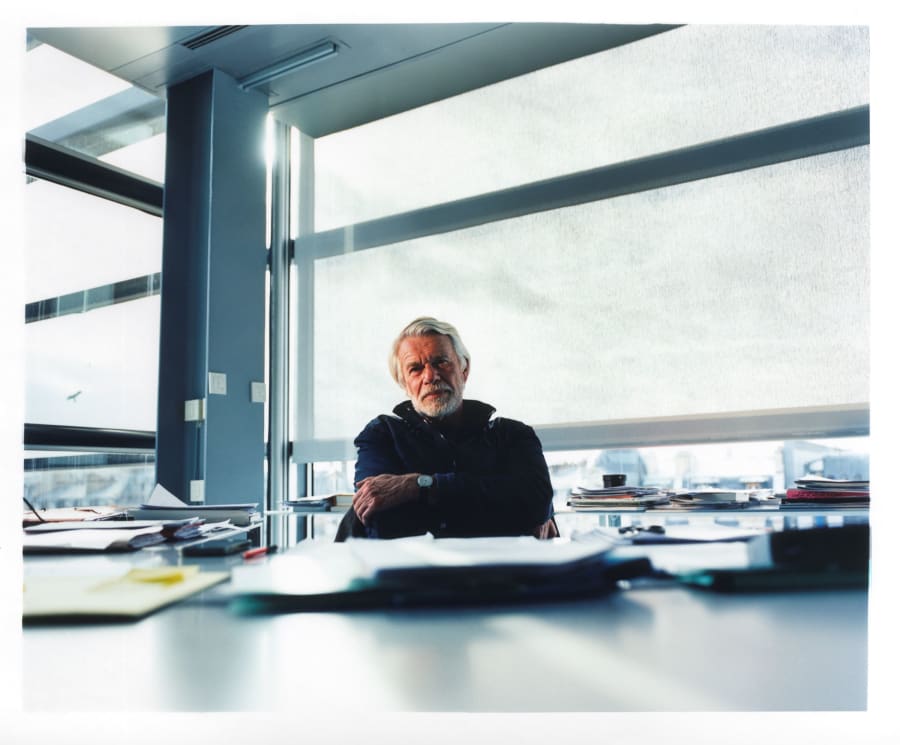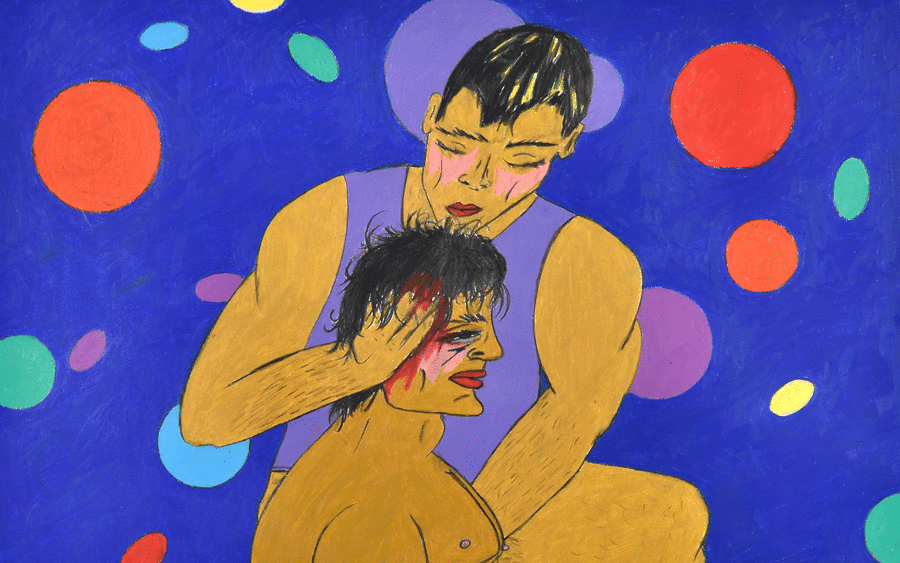At the edge of the Meudon and Clamart forests, not far from Paris, a steeply sloping street leads to the house that Sophie Taeuber designed in 1929 for herself and her husband, the sculptor Jean Arp. Ulla von Brandenburg arrives here in the company of actor Benoît Résillot, who has featured in several of her films. Within the house, painted crates serve as bookcases, coffee tables, and a desk, all conceived by Sophie Taeuber. Von Brandenburg immediately identifies a set of sculpted wooden chairs, and then remarks that, while there are two work spaces, there is no drawing room. The atmosphere is simple. One floor for Jean, one for Sophie.
Von Brandenburg has made work about a number of Modern artists in recent years: a tribute exhibition to Sonia Delaunay with Meris Angioletti in Piacenza, Italy; an interpretation of the first act of Oskar Schlemmer’s Triadisches Ballett (1912) at the Staatsgalerie Stuttgart in Germany; and the staging of an Arnold Schönberg play at the Wiener Festwochen (all in 2022). This has led her to choose the Fondation Arp as the destination for our walk. Above all, it is the figure of Taeuber that appeals to her; she has long been interested in the artist due to the lack of recognition she has received in comparison to her husband. Taeuber’s multidisciplinary work resonates with von Brandenburg’s own practice, all in halftones linked by gray: from textiles to sculpture, painting to furniture design, jewelry to illustration.
‘Sophie Taeuber doesn’t stop at any one medium – there is this idea of art as a whole. She makes no delineation between art and craft. It is a way of interweaving art and life, of wanting to live with things that we have made ourselves and that we make beautiful,’ explains von Brandenburg. She began making her way into the body of work of this free-spirited woman through the costumes Taeuber had created for the Cabaret Voltaire, a nightclub founded by Dada artists in Zurich, Switzerland. Taeuber was a pupil of Rudolf Laban, on whom von Brandenburg has worked extensively. For her the stage is an essential space. It often blends with domestic settings in order to welcome a troupe as a community. The images in von Brandenburg’s films, such as those screened at her exhibition ‘Le milieu est bleu’ at the Palais de Tokyo, Paris in 2020, seem to capture life itself, with its share of the unexpected and the random: ‘It is almost a story, but it is not really,’ comments Résillot.
Inside the house, which opened to the public two years ago, an exhibition showcases the spirit of Arp and Taeuber’s studio, and the theme of their intimacy emerges over the course of the visit. As Mirela Ionesco, the secretary of the Fondation Arp for some 30 years, shows us, Taeuber moved from medium to medium as effortlessly as she shifted from figuration to abstraction. Pages of notebooks revealing leaves and geometric shapes attest to this. ‘These are abstract worlds that become imaginary worlds, freed from all questions of representation,’ says von Brandenburg as she stops before a small gouache that catches her eye, its purple colors and flat gold leaf tints giving it a Byzantine accent. Just next to the painting, a work by Jean Arp takes up a similar motif in the form of a sculpture – a sign of the enigmatic connections uniting the work of this creative couple, and of the exchanges of ideas and forms that took place between them. ‘He took up her subject and feminized it… He added a breast to it,’ remarks von Brandenburg.
On the ground floor, a maquette of an arrangement of articulated geometric shapes evokes a costume created by Taeuber for the marionette show Le Roi-cerf (1918). For her latest film, Un bal sous l’eau (2023), von Brandenburg created puppets, though she points out that it was those of Paul Klee in particular that inspired her. Here her gaze is also drawn to a yellow lamp base and a small gray chest of drawers whose awkward-looking handles are in fact fitted with invisible notches to facilitate their use. In the bedroom, books covered in painted drawing paper are displayed on a shelf – wonderful embellishments of everyday life, these are the couple’s favorite books.
It is an idea worth remembering for von Brandenburg, who writes poetry that is sometimes used as dialogue in her films. A mannequin wears a pair of pants made of fabric rectangles sewn together in a harmonious asymmetry, recalling the colorful atmosphere of the costumes von Brandenburg designs for her creations and the quilts she is showing in her exhibition ‘Thoughts are Things’, currently on view at Pilar Corrias in London. ‘Sophie Taeuber had a way of thinking about the things that surround us that was very much in the spirit of the Bauhaus artists. And I share her ideas: for example, I don’t want just any cup or pair of pants. It is a very powerful gesture of emancipation from industrial society,’ says the German artist.
The transmission of knowledge and ideas is important to both artists. Sophie Taeuber taught in Zurich for many years, while von Brandenburg teaches at the Kunstakademie in her native Karlsruhe in Germany. ‘I want to impart to my students the sense that there are no mistakes in art – that you need to dare to do things. I have worked a lot on and around bodies. We live in a world today that distances us from the truth of our bodies. I try to return to the body because it is a domain where there are no limits. And I also want to guide my students to question what success is, which today is too often associated with monetary value.’
It is no coincidence that von Brandenburg is interested in an artist’s house that has since become a museum – especially when the one in question is Modern. In fact, one of her first films, Singspiel (2009), was shot at Le Corbusier’s Villa Savoye on the outskirts of Paris – it has to do with her own family history and her psychiatrist grandfather’s thinking on architecture in the wake of Walter Benjamin’s writings, particularly ‘Paris, capitale du XIXe siècle: le livre des Passages’ part of the Arcades Project (1982). ‘Whenever I get the chance, I explore artists’ houses – a few years ago, I did a project at the Musée national Gustave Moreau [in Paris]; I also visited Giorgio De Chirico’s house when I was a fellow at the Villa Medici [in Rome]. My house probably won’t become a museum, but I live in the country and it’s big, with a building next to the garden, where I shoot most of my films. We all eat and sleep on-site, with my children and my cats,’ describes von Brandenburg. During these times when something like an ephemeral community forms, creative territories blend, bringing together artists, musicians, writers, and more. This recalls the photos hanging in Sophie Taeuber and Jean Arp’s studio, where we recognize Max Ernst and Meret Oppenheim, but also James Joyce, and Theo and Nelly van Doesburg having lunch at a large table in the garden. And it is as if the sound of laughter comes floating up the stairs.
Ulla von Brandenburg is represented by Pilar Corrias (London) and Art : Concept (Paris).
‘Thoughts Are Things’ is on view at Pilar Corrias (London), until April 13, 2024.
Ulla von Brandenburg and Farah Atassi’s ‘La société des spectacles’ is on view at Fondation d’entreprise Pernod Ricard (Paris), until April 20, 2024.
Anaël Pigeat is an art critic, editor-at-large of The Art Newspaper, journalist for Paris Match, and curator.
Credits of the top image: Ulla von Brandenburg, Thoughts are Things 1 (detail), 2024. Courtesy of the artist and Pilar Corrias.
English translation: Jacob Bromberg.


